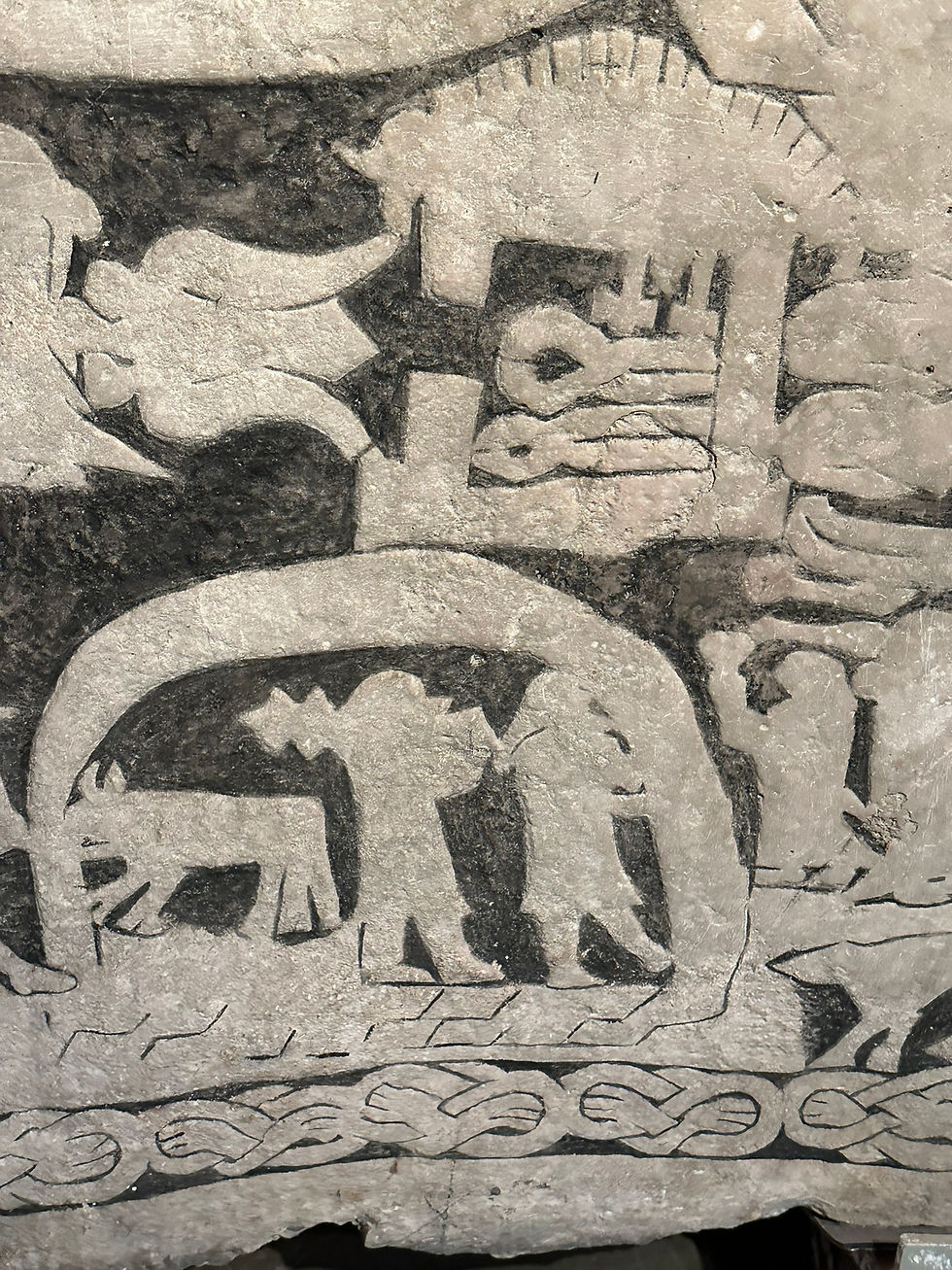THE ÖVERHOGDAL TAPESTRIES: THE WORLD TREE, PROCESSION, AND SHARED HERITAGE
- Hrolfr
- Sep 12
- 3 min read
Updated: Sep 12
The Överhogdal tapestries (Överhogdalstapeten), discovered in 1910 in a medieval church in Härjedalen, Sweden, are among the most significant textile survivals from the Viking Age and early medieval period. Dated between c. 1040 and 1170 CE, they straddle the transition from Norse heathenry to Christianity, preserving imagery that continues to fascinate scholars and practitioners alike.
Woven in wool with vivid plant-based dyes on linen warp, these five surviving pieces present a sweeping mythic procession: riders on horseback, ships, human figures, animals, and above all a great tree — widely interpreted as Yggdrasill, the World Tree of Norse faith.
The World Tree at the Center
At the heart of the Överhogdal imagery is a towering tree, rendered with curling, branching forms that dominate the composition. This tree is most often understood as:
Yggdrasill, the cosmic axis: the ash tree that binds together the Nine Worlds in Norse faith.
A symbol of continuity and renewal: Its presence in a textile woven during the conversion period may represent the persistence of pre-Christian cosmology even as new beliefs took root.
A ritual focus: Like the carved posts (öndvegissúlur) and staffs (seiðstafir) mentioned in saga accounts, the tree may have functioned as a sacred axis around which rites and narratives were organized.

The Horses in Procession
The tapestries famously depict riders on horseback moving toward or around the tree. Scholars have interpreted these in several ways:
The Einherjar: fallen warriors traveling toward Yggdrasill and the halls of the gods - Valhalla.
Funerary processions: horses as psychopomps, guiding the soul in its passage to the afterlife.
Ragnarök imagery: warriors riding to the final battle at the end of the world.
Whatever the specific meaning, the combination of tree and horses expresses a vision of movement between worlds, of mythic journeys anchored by a cosmic axis.
Between Heathen and Christian Worlds
The Överhogdal tapestries were woven at a moment of religious transition. Some scholars argue that the tree might simultaneously evoke the Tree of Life of Christian iconography and the Norse Yggdrasill, creating a syncretic blend of old and new faiths. Others emphasize its continuity with earlier Norse art, especially the Gotland picture stones, which also depict riders, ships, and ritual processions.
This ambiguity is part of what gives the tapestries their enduring power: they show us a community negotiating identity, belief, and heritage through sacred textile art.
Contemporary Use and Appropriation
In recent years, certain groups have adopted the Överhogdal tree motif as their exclusive emblem. While such usage demonstrates the continuing resonance of the imagery, it is important to stress:
The Överhogdal tapestries are a shared cultural inheritance, not the property of any one modern group or organization.
Their symbolism — the World Tree and the procession of riders — speaks to all who honor the Old Ways, across traditions, geographies, and interpretations.
Appropriating this image as a private or factional insignia diminishes its broader meaning, which rests precisely in its universality.
Just as Yggdrasill’s roots bind together many worlds, so too this motif belongs to the all Norse heathens.
Conclusion
The Överhogdal tapestries remain one of the most powerful visual survivals of Norse cosmology: the World Tree, the horses, the ships, and the human procession together form a mythic map of life, death, and renewal. They remind us that the old religion was not only spoken in myths and carved in stone but also woven into fabric — a medium both domestic and sacred.
Today, as in the 11th century, the tree and horses of Överhogdal serve as a reminder of connection: between past and present, between human and divine, and among all heathens who draw strength from the roots of their shared tradition. This is not the emblem of a single faction. It is the heritage of us all.


References
Andrén, Anders. Tracing Old Norse Cosmology: The World Tree, Middle Earth, and the Sun in Archaeological Perspectives. Nordic Academic Press, 2014.
Bender Jørgensen, Lise. Textiles in the Viking Age. Oxford University Press, 1992.
Rydh, Hanna. The Tapestries from Överhogdal. Stockholm: Kungl. Vitterhets Historie och Antikvitets Akademien, 1936.
Steinsland, Gro. Norrøn religion: Myter, riter, samfunn. Oslo: Pax Forlag, 2005.
Price, Neil. The Viking Way: Magic and Mind in Late Iron Age Scandinavia. 2nd ed. Oxbow Books, 2019.
Jamtli Museum (Östersund, Sweden). Överhogdal Tapestries exhibit notes.



Comments